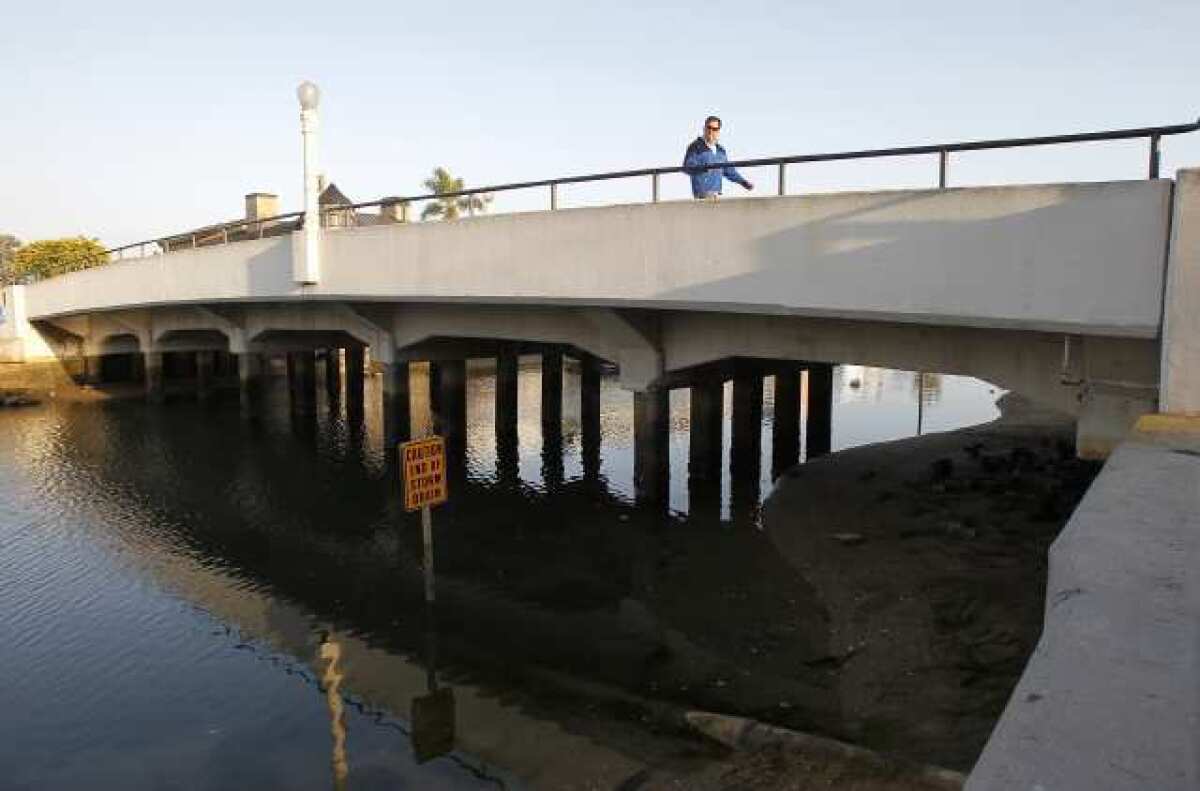Replacing bridge will be some feat

- Share via
It takes about five seconds to cross by car, maybe double that by foot.
Since about 1930, the Park Avenue Bridge has connected Little Balboa Island to its larger, more bustling neighbor, Balboa Island.
In the coming years, however, the situation there is poised to significantly, albeit temporarily, change for the steady streams of pedestrians and cars that traverse the bridge’s nearly 100-foot span.
After repeated official designations as “functionally obsolete” by the state, the nearly 85-year-old bridge is eligible for a complete replacement using federal funds, but the logistics of construction in the dense area — not to mention the fact that the bridge is Little Balboa’s only practical access point — are still being worked out.
“It’s just one of those projects that takes time to get through all the hoops,” said Councilman Ed Selich, whose district includes the two islands. “But there are still a few hoops to go.”
The city, California Department of Transportation, state Coastal Commission and federal authorities, to name a few, will be playing a role in the project, which is in its preliminary stages.
Though once they receive the various permissions and complete the design process, city officials hope to begin construction by late 2015, after summer, which is typically bustling. A one-year construction phase is anticipated for the estimated $2-million to $3-million bridge, with a new span in place in late 2016.
*
Initial trouble with the storybook curve
The Park Avenue Bridge — also called the Little Balboa Island Bridge or Little Balboa Bridge — has two narrow lanes for cars and pedestrian walkways on either side. Two ramps on each end of the bridge provide pedestrian access.
The bridge has remained largely unchanged since its late-1920s construction, though, according to the federal National Bridge Inventory, it is not eligible for the National Register of Historic Places.
With a slight upward curve, it gracefully spans in storybook fashion over the Grand Canal, which bifurcates the two islands of Newport Harbor.
While aesthetically pleasing, that curve was one of the initial hang-ups in getting approvals, said Selich, who added that a new Park Avenue Bridge has been a topic of discussion since his council tenure began in 2005.
“You couldn’t build it that way under new design standards,” Selich said.
Caltrans had to make an exemption for the planned replacement bridge to have the same curve, Selich said.
The state ruled the curve would be OK, he said, because of the low speed cars take to travel the span.
The city has received $240,000 for environmental review and engineering of a new bridge, which is planned to be wider for vehicles and pedestrians, said Pat Thomas, Newport’s deputy public works director.
The replacement would be 36 feet wide — four feet wider than now — with 12-foot wide car lanes, a slight increase over the current ones.
The pedestrian lanes would be wider as well. The concrete barriers currently on the outside of the bridge would be reconstructed onto the inside, thus better protecting and separating pedestrians from the passing traffic, Thomas said.
Replacing the outside concrete barrier would be open railings, he added.
“There would be a view and a pleasant little walk-across,” Thomas said.
Another addition: two small enclaves with benches that act as overlooks. Acorn bulb street lamps would also line both pedestrian lanes.
“We’re trying to keep as much of the historic look as possible, but it will be brand-new construction,” Thomas said.
Utility lines would also be new, and hidden as now. Little Balboa’s water, sewer and electricity connections are embedded within the bridge, and some are as vintage as the span itself. In particular, the water pipes are cast iron, Thomas said, and would be replaced with modern PVC pipe.
“It’ll be all new infrastructure going across there,” he said.
But like the other facets of a new Park Avenue Bridge, what to do with the essential utilities for Little Balboa residents is another challenge. They may have to be temporarily relocated, Thomas said.
The replacement structure would have four abutments from the water holding it up instead of the current six, Thomas said.
Those would be seismically sound, unlike the current abutments, he added.
*
Temporary bridge options
Since the bridge is Little Balboa’s only connection for pedestrians and cars, temporary bridge alternatives are being planned.
One option is a bridge spanning Balboa Avenue, just north of Park, Thomas said.
If this were to happen, an old railroad car’s deck — typically very structurally sound — could serve as a temporary bridge, Thomas said.
“It’s a 100-foot span,” Thomas said, “so it’s not out of the question of doing something like that.”
An idea to tear down and build half of the Park Avenue Bridge at a time is also floating around.
“Doing that is going to be complicated,” Thomas said, adding that it would create only one bridge lane, and cars on either end would have to take turns using it.
And for the walkers, strollers and runners, there could be a separate bridge just for them during the construction period.
This would provide safe passage away from the cars, Thomas said.
*
Construction woes
Tom Mellon sat in the yard of a home facing the Grand Canal on Friday afternoon, the skies clear and blue as throngs of folks only a few feet away on Marine Avenue bought trinkets, Balboa Bars and frozen bananas.
An island resident since 1979, Mellon knew of the Park Avenue Bridge plans — and the potential building chaos it will bring. He doesn’t live on Little Balboa but close enough to hear the area’s construction destiny.
“I’m sure at 7 a.m., they’ll be banging nails and pouring concrete,” Mellon said.
Selich said maintaining the bridge as is has been expensive.
“We’re spending a lot of money constantly repairing it, keeping it in good condition and keeping it good from an aesthetic standpoint,” he said.
Though Selich doesn’t live on Balboa or Little Balboa, he may be hearing the construction as well from his home across the harbor.
“You’re not going to reconstruct the bridge without some level of inconvenience,” he said.
As the planning process continues, Selich said the contractors will likely be mandated to park off-island, take shuttles to the site and do construction work off-site as well.
A few public meetings with islanders have already taken place, and city officials said support is there for a new bridge.
Jeff Herdman, president of the Balboa Island Improvement Assn. and Little Balboa Island Property Owners Assn., expressed his enthusiasm for the project in the March/April edition of The Island Bridge, the island’s “only official” newsletter.
“I have attended no less than three meetings to provide input, to review plans and drawings, and to have a ‘voice’ in terms of representing Little [Balboa] Island Property Owners,” Herdman wrote, calling the bridge “beautiful in design.”
Mellon said he too is OK with a new bridge. After all, it’s needed.
“They say it’s starting to crumble in places.”
Twitter: @bradleyzint
All the latest on Orange County from Orange County.
Get our free TimesOC newsletter.
You may occasionally receive promotional content from the Daily Pilot.




